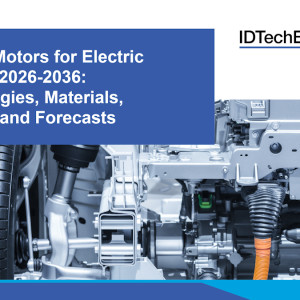New IDTechEx Report: Electric Motors for Electric Vehicles 2026-2036


Electric motors truly are the driving force behind electric vehicles (EVs). In addition to the batteries and power electronics, the electric motor is a critical component within the drivetrain. Despite electric traction motors originally being developed in the 1800s, the market is still evolving today with new designs, improving power and torque density and more considerations around the materials used.
These aren't just incremental improvements either, with developments such as axial flux motors and various OEMs eliminating rare-earths altogether.
This report from IDTechEx[1], "Electric Motors for Electric Vehicles 2026-2036: Technologies, Materials, Markets, and Forecasts[2]", details OEM strategies, trends, and emerging technologies within the motor market for EVs. An extensive model database of over 700 EV model variants sold between 2015-2024 in several geographic regions aids in a granular market analysis of motor type, performance, thermal management, and market shares.Technologies and strategies of major OEMs are considered for cars, two-wheelers, three-wheelers, microcars, light commercial vehicles (vans), trucks, and buses along with several use-cases and benchmarking of several motor units. Emerging technologies are also addressed with market forecasts through to 2036 such as axial flux and in-wheel motors.
Motor requirements and use cases are detailed for eVTOL (electric vertical take-off and landing) and eCTOL (electric conventional take-off and landing) aircraft as a much earlier stage market, with demanding performance characteristics.
Key aspects of this report
Analysis of the electric motor markets in BEVs, PHEVs and HEVs across cars, two-wheelers, three-wheelers, microcars, light commercial vehicles (vans), trucks, buses, eVTOL, and eCTOL including:
- Benchmarking different motor types/topologies
- OEM strategies
- EV industry trends and the impact on electric motors
- Trends in motor design
- Emerging motor technologies and benchmarking: axial flux, in-wheel, and switched reluctance
- Materials utilization: magnets (including rare earths) and windings (round or hairpin)
- Thermal management of electric motors
- EV use-cases and benchmarking
- Supply relationships between OEMs and tier 1s
- Company profiles including interviews
10 Year Market Forecasts & Analysis:
- Automotive electric motor forecast 2015-2036 (regional): China, Europe, US and rest of world (units, kW)
- Automotive electric motor forecast 2015-2036 (drivetrain): BEV, PHEV and HEV (units, kW)
- Automotive electric motor forecast 2015-2036 (motor type): alternating current induction motor (ACIM), permanent magnet (PM), wound rotor synchronous motor (WRSM), permanent magnet rare earth free, other rare earth free, axial flux (units)
- Automotive electric motor value forecast (drivetrain): BEV, PHEV and HEV (US£)
- Micro-EV motor forecast: two-wheelers (<4 kW and >4 kW), three-wheelers (<4 kW and >4 kW), microcars (units, kW, and US£)
- Electric light commercial vehicle (van) motor forecast: BEV & PHEV (units, kW, and US£)
- Electric truck motor forecast: medium- and heavy-duty BEV & PHEV (units, kW, and US£)
- Electric bus motor forecast: BEV & PHEV (units, kW, and US£)
- Automotive HEV motor forecast: China, Europe, US, Japan, South Korea and rest of world (units, kW)
- Automotive axial flux motor forecast (units)
- In-wheel motors forecast (units)
- Materials for motor magnets forecast split into elements (tonnes)
- Forecast for aluminum, copper, and steel (tonnes)
References
- ^ IDTechEx (www.idtechex.com)
- ^ Electric Motors for Electric Vehicles 2026-2036: Technologies, Materials, Markets, and Forecasts (www.idtechex.com)